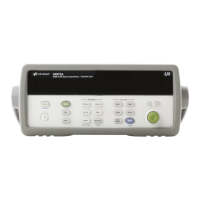Features and Functions 4
Keysight 34970A/34972A User’s Guide 139
RTD measurements
To connect an RTD to the module’s screw terminals, see page 39.
– The instrument supports RTDs with α = 0.00385 (DIN / IEC 751) using ITS-90
software conversions or α = 0.00391 using IPTS-68 software conversions.
The default is
α
= 0.00385.
– The resistance of an RTD is nominal at 0 °C and is referred to as R
0
. The
instrument can measure RTDs with R
0
values from 49Ω to
2.1 kΩ. The default is R
0
= 100Ω.
– “PT100” is a special label that is sometimes used to refer to an RTD with α =
0.00385 and R
0
= 100Ω.
– You can measure RTDs using a 2-wire or 4-wire measurement method. The
4-wire method provides the most accurate way to measure small resistances.
Connection lead resistance is automatically removed using the 4-wire method.
– For 4-wire RTD measurements, the instrument automatically pairs channel n
with channel n+10 (34901A) or n+8 (34902A) to provide the source and sense
connections. For example, make the source connections to the HI and LO
terminals on channel 2 and the sense connections to the HI and LO terminals
on channel 12.
– Front-Panel Operation: To select the 2-wire or 4-wire RTD function for the
active channel, choose the following items.
TEMPERATURE , RTD , RTD 4W
To select the nominal resistance (R
0
) for the active channel, choose the
following item.
R
o
:100.000,0 OHM
To select the RTD type (α = 0.00385 or 0.00391) for the active channel, choose
the following item.
ALPHA 0.00385
– Remote Interface Operation: You can use the MEASure? or CONFigure
command to select the probe type and RTD type. For example, the following
statement configures channel 301 for 2-wire measurements of an RTD with α =
0.00385 (use “85” to specify α = 0.00385 or “91” to specify α = 0.00391).
CONF:TEMP RTD,85,(@301)

